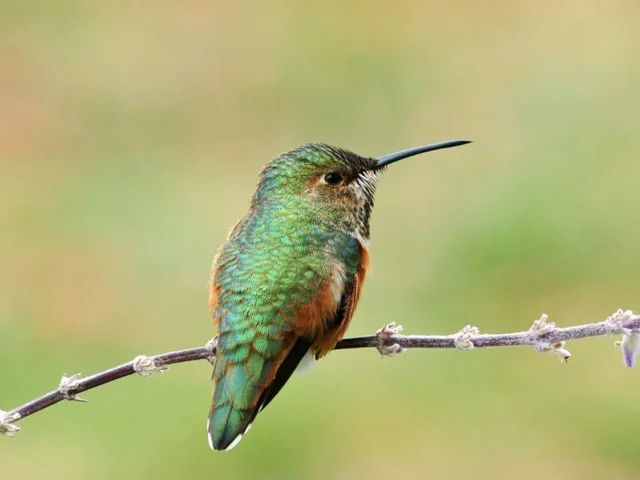Allen’s Hummingbird boom missed by American breeding bird surveys
fcc3c734-0b9a-48b7-83bd-2f228f008b84

Population declines indicated by breeding surveys of Allen’s Hummingbird have seen it placed on several conservation watch lists, but birders have contradicted this story.
Concerns that climate change may push the species out of Southern California have been exacerbated by the reported reduction in numbers. However, local birders have reported that the non-migratory subspecies of Allen’s Hummingbird, once restricted to the Channel Islands of the Californian coast, is now a common sight at feeders in Riverside and Los Angeles. Why the discrepancy?
The University of California-Riverside’s Chris Clark used data from eBird, an online platform where citizen scientist birders can submit their sightings, to re-examine Allen’s Hummingbird population trends in urban Southern California since 1990. He found a steep increase in the species’ prevalence in eBird records from the region, with Allen’s Hummingbirds reported in 20 per cent of all checklists submitted from Southern California today. Because the pattern is consistent year-round, it cannot be driven by the migratory subspecies, which is only in the area for part of the year.
While it appears that urban landscaping has created new habitat and food supplies that are exploited year-round by non-migratory Allen’s Hummingbirds, ecological differences between the two subspecies could also be helping to drive their different trajectories.
“The non-migratory Allen’s Hummingbird seems to do better in parks and backyards than does the migratory subspecies,” says Clark. “It also produces more offspring during the breeding season. Either of these reasons might be why the non-migratory subspecies seems to be doing so well within urban areas of the greater Los Angeles area.”
“This commentary is an object lesson in the importance of considering all sources of data and all aspects of a species’ natural history when its range and trends are modeled. As Clark emphasises, the accuracy of such models matters when they are the basis for setting conservation priorities,” according to Philip Unitt of the San Diego Natural History Museum. “The paper calls attention to the continuing dramatic increase in the range and numbers of Allen’s Hummingbird, bringing into contact two subspecies differing in multiple aspects of their biology, an opportunity for study of evolution in process.”
Reference
Clark, C J. 2017. eBird records show substantial growth of the Allen's Hummingbird (Selasphorus sasin sedentarius) population in urban Southern California. The Condor 119: 122-130. doi: http://dx.doi.org/10.1650/CONDOR-16-153.1
Concerns that climate change may push the species out of Southern California have been exacerbated by the reported reduction in numbers. However, local birders have reported that the non-migratory subspecies of Allen’s Hummingbird, once restricted to the Channel Islands of the Californian coast, is now a common sight at feeders in Riverside and Los Angeles. Why the discrepancy?
The University of California-Riverside’s Chris Clark used data from eBird, an online platform where citizen scientist birders can submit their sightings, to re-examine Allen’s Hummingbird population trends in urban Southern California since 1990. He found a steep increase in the species’ prevalence in eBird records from the region, with Allen’s Hummingbirds reported in 20 per cent of all checklists submitted from Southern California today. Because the pattern is consistent year-round, it cannot be driven by the migratory subspecies, which is only in the area for part of the year.
While it appears that urban landscaping has created new habitat and food supplies that are exploited year-round by non-migratory Allen’s Hummingbirds, ecological differences between the two subspecies could also be helping to drive their different trajectories.
“The non-migratory Allen’s Hummingbird seems to do better in parks and backyards than does the migratory subspecies,” says Clark. “It also produces more offspring during the breeding season. Either of these reasons might be why the non-migratory subspecies seems to be doing so well within urban areas of the greater Los Angeles area.”
“This commentary is an object lesson in the importance of considering all sources of data and all aspects of a species’ natural history when its range and trends are modeled. As Clark emphasises, the accuracy of such models matters when they are the basis for setting conservation priorities,” according to Philip Unitt of the San Diego Natural History Museum. “The paper calls attention to the continuing dramatic increase in the range and numbers of Allen’s Hummingbird, bringing into contact two subspecies differing in multiple aspects of their biology, an opportunity for study of evolution in process.”
Reference
Clark, C J. 2017. eBird records show substantial growth of the Allen's Hummingbird (Selasphorus sasin sedentarius) population in urban Southern California. The Condor 119: 122-130. doi: http://dx.doi.org/10.1650/CONDOR-16-153.1

